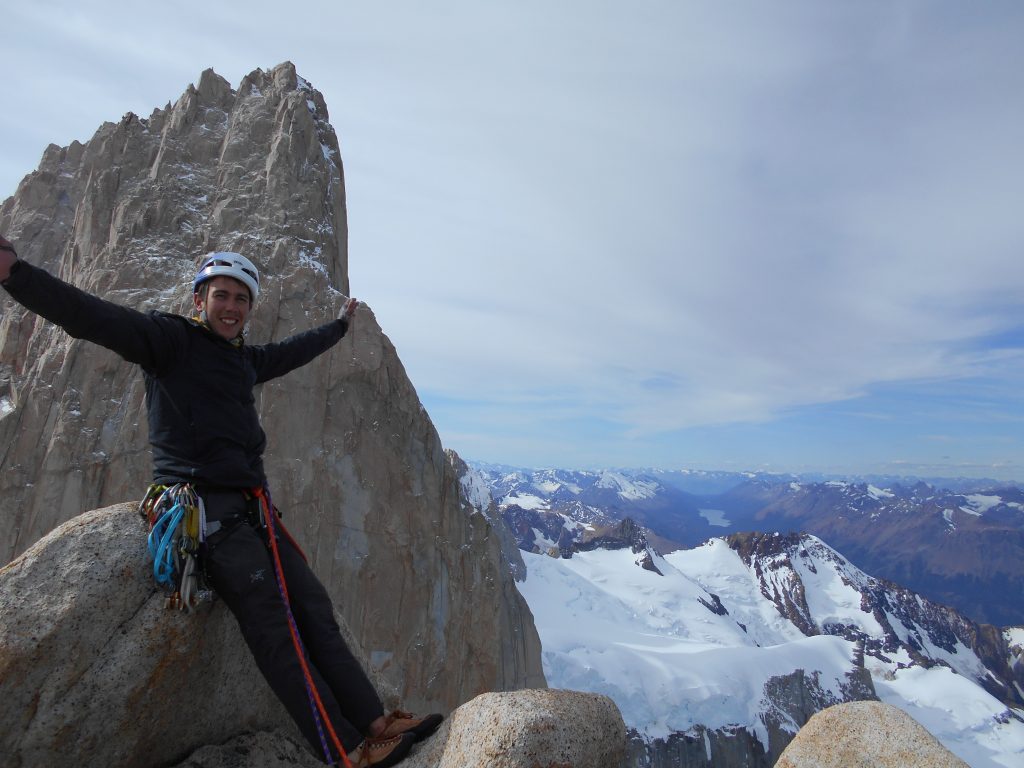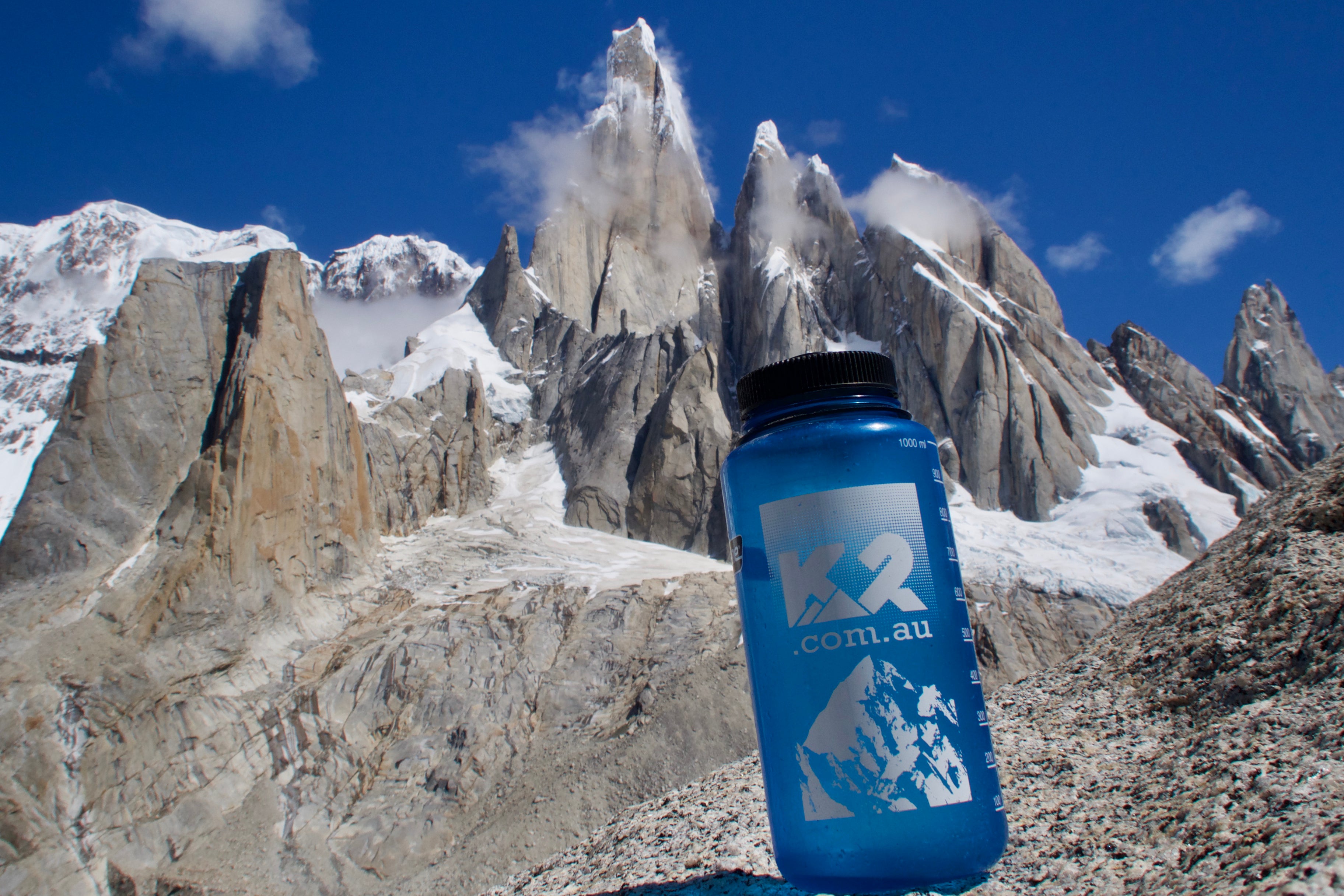Written by K2 Team Member Daniel Laing
In early 2020 I spent close to five weeks in the small Argentinian outpost of El Chalten, Patagonia, where on a clear day, the peaks of the Fitz Roy range stare down at you demanding your attention. Jack and I arrived with modest goals, hoping to climb what mother nature would allow us while remaining acutely aware of our limited experience in such a vast and harsh playground. In the first month, we made a few forays into the Fitz Roy range.
Lugging our heavy packs for many hours over tourist tracks, scree, collapsed hillsides and glaciers, we held out hope of encountering a long enough weather window for success. Unfortunately, high winds and icy conditions kept getting the better of us, forcing hasty retreats with tails between our legs. These were memorable days none the less.
Finally, a window of five days of good weather arrived and the valley was transformed with opportunities for adventure that seemed endless. After summiting the ‘warm-up’ peak of Aguja Rafael Juárez we spent a day resting in the alpine sun preparing for an attempt on the famous Chiaro di Luna on Aguja Saint Exupery.
This is the route we had come for, although it seemed hard to believe that the opportunity had finally presented itself and that we were going to get our chance.
The experience of climbing Chiaro di Luna
As the moonlight cast a shadow across the major peaks in the Fitz Roy Valley, I lay in my sleeping bag pretending I could fall asleep. Instead, I felt the wave of nervous energy running through me. From our five-star bivy, I could see headlamps high on Cerro Torre and way down on the glacier below.
I rolled over, gazed up at Saint Exupery and tried to pick out tomorrow’s route before being distracted by the headlamps of climbers abseiling down the North face. It was late and dark, but they were still high up - would that be us tomorrow? At some point, I must have drifted off.

The approach
The waking alarm sounded 3AM. The air was cold and I felt like I’d just got to sleep. For his part, Jack was already bouncing around and getting the stove ready. I left the warmth of my sleeping bag and forced down our food rations of porridge and coffee before packing up the sleeping gear and heading for the base of the route. Having completed most of the approach (and all the steepness) the day before it was a fairly straightforward 30-minute boulder hop to the base of a massive diagonal basalt dyke that cuts across the west face and signals the start of the route.
Jack set off up into the darkness while I switched off my headlamp to save the battery and tried to dodge the loose rocks that trundled toward me at intervals. Looking down into the gully below I could see the owners of last night's headlamps finally reaching the ground to which they let out a relieved shout.
The crux
After a couple of pitches up the basalt dyke we reached the pristine granite Patagonia is famed for and the start of the proper climb. The crux pitch was next and involved some strenuous bridging and laybacking up a beautiful corner. Jack led just as daylight had broken and having injured his bicep on an earlier trip into the mountains, we were both anxious to see if it would affect him. He made it through the pitch without any issues and from here we knew it was on! As Jack reached the top of the pitch, he started singing Faith by George Michael, an extremely catchy song and one that would be in our heads for the rest of the day.


The game plan
To save time we found it best to lead in blocks of pitches; four or five each before swapping. It worked well as it gave the leader a few pitches to get into a rhythm while allowing the second to rest, eat and drink. After Jack led four pitches, I led the next five following the beautiful crack lines that made for straight-forward, enjoyable climbing. Our route was easy to protect and we made good progress.
Along the climb, Jack suggested simul-climbing to save even more time. Having never simul-climbed, all I was given was a 5-minute crash course before setting off. It seemed pretty simple. As long as nobody fell, everything would be fine. Simul-climbing went well until I reached a particularly iced up section where you were required to climb very carefully and precisely through steep terrain.
At that point, I didn’t realise Jack had already reached the belay and that there was no danger ahead. We had arrived at a massive ledge where some people choose to spend the night and climb the route over two days. It was the perfect spot to have lunch, reorganise our gear and relax for a while. The pitches above looked awesome!

The final pitches
The next few pitches were steeper, and the exposure really kicked in thanks to the height we had gained. Pitch 14 was a standout and perhaps the best pitch of the route. It starts up one crack before transitioning to a parallel crack on the left until it runs out, leaving a committing move over to a thin left-facing flake which after some exposed laybacking leads to the belay. Another six or so pitches of strenuous crack climbing and bridging up a wide chimney feature, we were in position to reach the top. We summited Chiaro di Luna at 6PM after 11 hours of climbing. From here, we took the time to savour the 360° views of sky, snow, rock and ancient glaciers before the cold snapped us back to reality for the climb down.
The way down
Abseiling down was tricky. We got our ropes stuck multiple times and were forced to use lots of trickery and hard labour to get down. Despite this, I learnt a lot. It was also quite scary, some of the old tat on the rap stations were hardly inspiring. On the steeper raps, I said a few prayers that our ropes wouldn't get stuck and leave us stranded. At one point we both hung off a sling round a spike in the middle of a blank steep wall giggling with nervous energy. The relief to get back on slabbier ground was massive. We completed the last few raps in the dark and eventually reached the gully at the bottom of the north face.
However, we were not done yet, as getting down the gully still involved abseiling down hundreds of meters of chossy slabs to reach the walkable ground. Exhausted at this test of endurance, we were seemingly forced to endlessly abseil down the slabs in the dark trying to find the next bit of tat to abseil off while fighting knots and tangles in the rope. The earlier fun in the day seemed like a long time ago now. Finally, we got to our boots at the base of the basalt dyke. After 7 hours of abseiling, we were down!
We got back to our bivy spot in the early hours of the morning. I mostly felt relief at getting back safe but also hugely satisfied to have climbed the route we’d dreamed of before the trip. The glow of climbing Chiaro di Luna would linger for a long time to come.
Until the next time.

